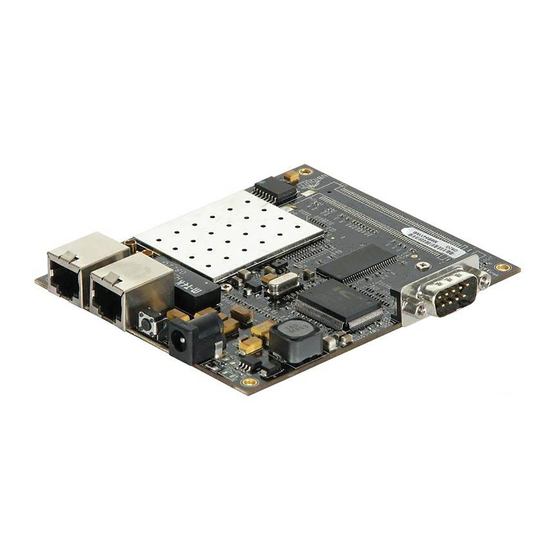Table of Contents
Advertisement
Quick Links
Advertisement
Table of Contents

Subscribe to Our Youtube Channel
Summary of Contents for Ubiquiti LiteStation2
- Page 1 LiteStation2 User’s Guide...
-
Page 2: Table Of Contents
Contents Contents ..................2 Quick Setup Guide ..............3 Configuration Guide ..............7 Main Settings................8 Link Setup ................9 Basic Wireless Settings ............9 Wireless Security .............. 10 Network Settings .............. 12 Advanced Link Setup............12 Advanced Wireless Settings..........12 802.11e QoS (WMM) Settings .......... -
Page 3: Quick Setup Guide
Step 2 Configure network settings The IP configuration as described below is required for LiteStation2 management purposes. IP addresses can either be retrieved from a DHCP server or configured manually. Use the Link Setup menu to configure the device IP settings: Bridge IP Address: specify the IP mode. - Page 4 IP Address: enter IP address for subscriber station LiteStation2. Netmask: enter a subnet mask for subscriber station LiteStation2. Gateway IP: enter a gateway IP address for subscriber station LiteStation2. Step 3 Assign an ESSID to subscriber station Use Link Setup menu to specify the ESSID of the wireless device to...
- Page 5 Authentication Type: choose the one of the following modes. network. Open Authentication – the LiteStation2 is visible to all devices on the network. Shared Authentication – allows communication only with other devices with identical WEP settings.
- Page 6 After the general settings are changed, the subscriber station is now be sure to use the new address ready for basic operation. You can now use the web interface menu to the next time you access the configure many more details for your LiteStation2. configuration interface.
-
Page 7: Configuration Guide
Configuration Guide Each of the management windows (listed below) contains parameters that affect a specific aspect of the subscriber station: Figure 1 – Configuration Management Menu Main – displays current status of the subscriber station. Link Setup – prepares the subscriber station for use in a wireless network, controls how a subscriber station associates to an access point, authenticates to the wireless network, and encrypts and decrypts data. -
Page 8: Main Settings
TX Rate: displays the current data transmission rate. RX Rate: displays the current data reception rate. Channel: displays the channel that LiteStation2 uses to transmit and receive data. Frequency: displays the frequency at which LiteStation2 transmits packets to or receives packets from Access Points. -
Page 9: Link Setup
Use the Select… button next to ESSID entry field to load the Site Survey tool. Site Survey will search for all wireless networks (SSID) in range of the LiteStation2 and allow you to select one for association. In case the selected network uses encryption, you first need to setup encryption on your LiteStation2. -
Page 10: Wireless Security
802.11g Dynamic Turbo mode for data rates up to 108 Mbps. Data Rate: choose the data rates in Mbps at which LiteStation2 should transmit packets to or receive packets from Access Point. Use The list of data rates will vary... - Page 11 Authentication Type: choose the one of the following modes. Open – the LiteStation2 is visible to all devices on the network. Shared Key – allows communication only with other devices with identical WEP settings. WEP (Wired Equivalent Privacy) is based on the IEEE 802.11 standard and uses the RC4 encryption algorithm.
-
Page 12: Network Settings
DHCP – choose to assign the dynamic IP address and gateway address by the local DHCP server. Static – choose to assign a static IP address for the LiteStation2. Be sure that the DHCP server is IP Address: enter IP address for subscriber station LiteStation2. -
Page 13: 802.11E Qos (Wmm) Settings
RTS Threshold: determines the packet size of a transmission and, through the use of an access point, helps control traffic flow. The range is 0-2347bytes, or word ‘off’. The default value is 2347 (2347 means that RTS is disabled). Fragmentation Threshold: specifies the maximum size for a packet before data is fragmented into multiple packets. -
Page 14: Antennas
Use this section to find out current software version and update with new firmware. Use only an official Ubiquiti The LiteStation2 subscriber station system firmware update is firmware image for update. compatible with all configuration settings. When the device is updated with a newer version or the same version builds, all the system’s... - Page 15 The new firmware image is uploaded on the system, use Upgrade button to upgrade a new system firmware: Do not switch off and do not disconnect the LiteStation2 from the power supply during the firmware upgrade process as this can damage the device! Figure 14 –...
-
Page 16: Administrative Account
Change: click to change the login details of administrator. Logo Customization Use this section to enable and upload your custom logo on the LiteStation2 user interface. The logo must conform to these limitations: The limit of logo size is 50Kb. -
Page 17: Device Maintenance
Logo File: click Browse… button to navigate to and select the logo file or specify the full path and click the Upload button. Change: click to change the logo on the LiteStation2 user interface. Device Maintenance Use this section to reboot subscriber section or reset station parameters to factory default values: Figure 18 –...

















Need help?
Do you have a question about the LiteStation2 and is the answer not in the manual?
Questions and answers